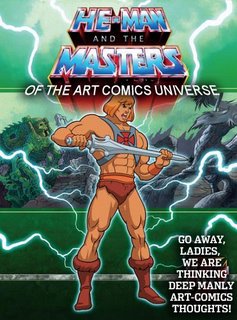Silly Girl, Only Men Can be "Masters of Cartooning"!
Put down that brush, you might get ink on your pretty little fingers!

My first thought when I heard of the "Masters of American Comics" coffee-table book and gallery show was "Cool." And my second thought was: "I wonder if they included any Misstresses of American Comics?" The answer, of course, was no. As Natalie Nichols writes in her review of the show ("Where the Girls Aren't"):
What becomes a Comics Master most? What else but that all-important authoritative accessory, a penis?andSorry, just had to get that off my chest. Because, yeah, I know: The joint exhibition Masters of American Comics, currently on view at the UCLA Hammer Museum and MOCA?s Grand Avenue, is not a comprehensive look at U.S. comics creators over the last 100-plus years (some of whom actually were ? gasp! ? women). It's a sampler of sorts, an "in-depth analysis" of 15 pioneering American comics artists whose influential innovations blended a mastery of craft with an ability to create atmosphere and emotion on the page.
Why not include passing mentions of Dale Messick, creator of Brenda Starr (which debuted in 1940); '50s EC artist Marie Severin, who also worked for Marvel from the '60s to the '90s; Ramona Fradon, a DC Comics artist in the '50s and '60s, who also drew Brenda Starr after Messick's 1980 retirement; or Wendy Pini, cocreator of the 28-year-old ElfQuest series, which, among other things, was manga-influenced long before most U.S. artists took to the now hugely popular Japanese comics? Instead, female cartoonists are relegated to a brief acknowledgement of the '70s emergence of artists like Trina Robbins and Aline Kominksy-Crumb.
To her list of pioneering "why not mentions..." I'd also add Roberta Gregory. Ironically enough, Ms. Nichols' piece appears in an L.A. Citybeat comics-themed issue that includes interviews with such awesome cartoonists as David Rees and Kyle Baker... but not one woman cartoonist.
In another similar irony, I was looking over some sample syllabi for teaching comics as literature at the excellent National Association of Comics Art Educators site. Most of the comics as literature courses include texts by at least one woman cartoonist, but all twelve of the primary texts for this Yale course ("Comics as Literature, Comics as Art") are by men (and all white men at that, I think), and even the long optional "supplementary reading" list includes only one or two women. But my favorite is this item in the optional historical reading:
Trina Robbins, The Great Women Superheroes (1996). Also, A Century of Women Cartoonists (1993) and, with Cat Yronwode, Women and the Comics (1985). A subject not spoken about enough.
I love the passive tense there. If he were honest, he would have said "A subject I didn't care enough about to include in my course." (Those books are excellent histories, however, check them out at Ms. Robbins web site).
Really, we shouldn't have to be dealing with this crap anymore. This should be old hat. After all the "women in comics" and "where the hell are the women in comics?" panels and articles, why do so many guys still have a mental block on women cartoonists or cartoons by women? It's true that the comics world (like the editorial cartooning world) is still male-dominated, but collections like "Masters in Comics" don't just innocently reflect that domination, they perpetuate it. There are plenty of amazing brilliant women cartoonists out there. Check out this crazy-ass long list from Friends of Lulu of "Women Doing Comics," or some of the cool women in my links list.
As a side note, as I was writing this post I received an email from a magazine editor asking me if I could send her a list of women political cartoonists. Apparently a male writer had proposed a piece about editorial cartoonists and was insisting that there was only one woman worth mentioning in the entire field. Sigh... I guess he never heard of Pulitzer-prize winners Signe Wilkinson and Ann Telnaes, pioneering cartoonist Etta Hulme, or alternative cartoonists such as Jen Sorensen, Stephanie McMillan and yours truly.
- Further reading about the lack of women in the Masters show:
- "Why have there been no great women comic-book artists?" This piece seems to unable to decide if its because there weren't any good women artists or that the styles preferred by women have been overlooked in favor of superhero comics. But that's no excuse--some of the "Masters" in the book, like Chris Ware, are much more recent, and there are plenty of contemporary women masters of comics.
- The above article sparked a (initially male-dominated) debate on the TCJ message board. Choice excerpt:
women artists are generally nothing but trouble... there's always a lot of emoting and waving of their arms through the air. their work is generally of a lesser caliber and usually strays from 'fine art' into the realm of 'self-expression'. that's fine when you're in college, but not so hot in the real world.
- The curator of the exhibit acknowledges that he's received complaints about the lack of women but insists "this is just one show."




0 Comments:
Post a Comment
Links to this post:
Create a Link
<< Home